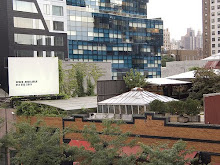


 1).
1). Long Island City’s past as an industrial hub. (QWDC). 2)
Buildings and residential booms create the new backdrop of the gantries. 3)
Hunter’s Point brownstones, are stuggling to survive amidst the greater demand for luxury condo’s and residences. 4)
The city holds different events to attract crowds to Long Island City. You could see the different high rises that only continue to pop up and the banner promoting new condo’s and rentals available. (Queens Chronicle)
For those of us who have lived in New York for our entire lives, or even during the past 10 years, it is not difficult to see that many of the neighborhoods are changing. Recent years have shown a reversal of suburban flight; many young people and single people are seeking the city for its promise of opportunity, and connections. Many city leaders welcome this as they see this as an answer to years of urban neglect and never-ending urban city debt. (Howell,2008) The influx of new residents, mostly those of affluent backgrounds is embraced by the state because of the promise of revenue and resources brought to the city. But how do these typically “run-down” places attract these new affluent residents? Well, one of the ways NYC made it happen was through the “Zero-tolerance” policy or Police Strategy No. 5 which would reclaim the public spaces of New York, implemented by Mayor Rudy Guiliani in the early 90’s (Harcout, B. & Ludwig, J.,2006).
Gentrification advocates use of such vocabulary as “renewal” and “revitalization” is bothersome to many. The use of this language implies that whatever is currently in the neighborhood is dead weight that needs to be revitalized and building on property is needed. According to NYU’s Furman Center “only 4.6% of homes for sale in New York City in 2005 were affordable to people making the city's median income of $43,434. Meaning that for NYC’s working and middle class, living in NYC is getting tougher by the year (Messina, 2008) One of these places is Long Island City.
Long Island City is located in western Queens across the East River from Midtown Manhattan and the Upper East Side. Although many people don’t know Long Island City is composed of several neighborhoods including Astoria, Dutch Kills, Sunnyside, and Hunter’s Point. Historically speaking Long Island City has always been an industrial area. For many years the factories ranging from those that made clothing, auto parts, home appliances, and more filled the streets of Long Island City. After factories closed for the day the desolate streets became sites of drug junkies and illicit activies. For many years the ports on the East River served as a route for goods to and from Manhattan to the rest Queens and Long Island. Now the ports serve as a decorative piece amidst the ever erupting new residential buildings being built on the Queens Waterfront. The renewal of Queens West is headed by Queens West Development Corporation their mission statement declares the following “Since its creation, Queens West Development Corporation (QWDC) has done much to transform a derelict and contaminated waterfront area into what is now a vibrant and thriving community. The project has constructed seven residential buildings (providing over 2,600 units of housing), retail amenities, public streets and utilities, a public school, and 10 acres of public parkland and recreation areas.
” The project will include four additional residential buildings and a public library. Private sector development partners include Rockrose Development Corp and Avalon Bay Communities.
In May of 2009, approximately 30 acres of this property was transferred to the City of New York for construction of its own Hunters Point South project, which will include 5,000 units of housing (60% of which will be for middle income residents).” (QWDC,2009) There are already 2 huge buildings and according to the QWDC there are 10 more in the works.
The neighborhood is quickly changing and the once industrial community is becoming a residential, expensive neighborhood, where old residents and business owners are feeling the pinch of more expensive property and residents seeking “hipper” restaurants, grocers, and recreation. Business owners especially those on Vernon Blvd, just a few blocks from the ports, express their fears of losing their businesses and being bought out by real estate agents. According to an article in the Queens Chronicle “New business is raising property values, those living on fixed incomes who can’t afford the new prices may have no place to go.”
- Diana Andrade and Lydia S. Guerra
Directions
7 Train to Vernon Blvd/Jackson Avenue. Leave the station and explore.
References:
Fertoli, A. (2007, July 19). LIC’s Vernon Boulevard on the rise. The Queens
Chronicle. Retreived from http://www.zwire.com/site/news.cfm?newsid=
18605468&BRD=2731&PAG=461&dept_id=574903&rfi
Harcourt, B. & Ludwig, J. (2006). Broken Windows: New evidence from New York
City and a five-year social experiement. University of Chicago Law Review,11,
271-320.
Howell, R. (2008). Throw the "Bums" Out? A Discussion of the Effects of Historic
Preservation Statutes on Low-Income Households Through the Process of
Urban Gentrification in Old Neighborhoods. The Journal of Gender, Race &
Justice 11,pg541
Messina, J. (2008). Unaffordable NY: Tough choices at $150,000. Economic
Report, 16.
Smith, N. (1998). Guiliani Time: The Revanchist 1990s. Social Text,57, 1-20
Broken Windows: New Evidence from New York City and a Five-City Social Experiment

Long Island is one of the best touring places for tourists that can make your trip day wonderful. Great! best park and fly
ReplyDelete